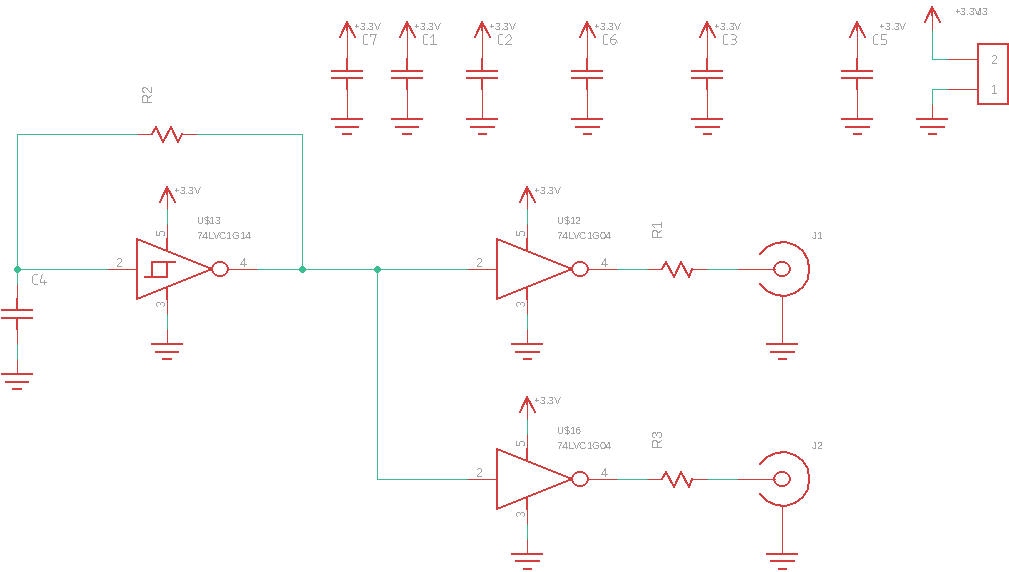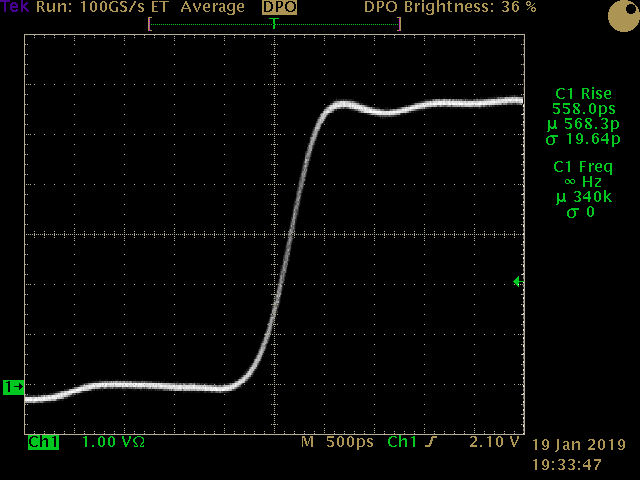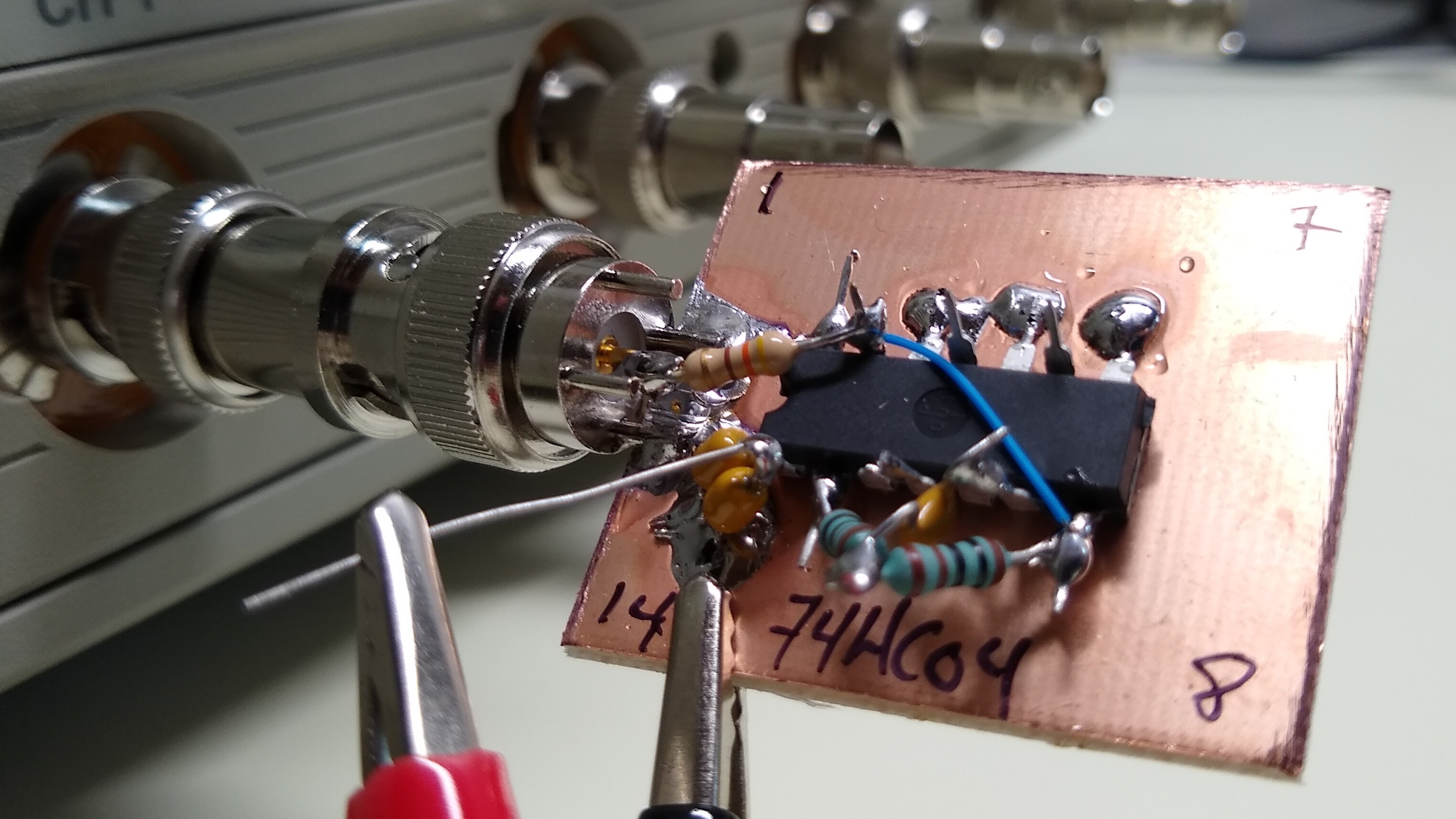I finally populated a couple of PCBs I designed about a month ago. These are simple Schmitt-trigger oscillators with 74xx1G04 inverter output buffers. I populated one with 74LCV1G devices and one with the faster SN74AUC1G to compare the edge rates - the results were surprising.

The circuit is shown below. I didn't populate one of the inverters intended to drive a sync output. The output series resistor is 453 ohms, creating a 10x divider when used on a scope with 50-ohm input termination. An SMA-BNC adapter lets you connect the board right at the scope input with no intervening cable to slow the rise time.

ADCMP606
As a baseline, I re-measured my ADCMP606 version. This uses a CML-output comparator with typical datasheet rise times of 160 ps. On my 1 GHz scope, it measures 392 ps, which is more the scope than the pulse. For the rest of the measurements, I'll assume the ADCMP606 is actually creating pulses with 160 ps rise time, so the scope's rise time is sqrt(392^2 - 160^2) = 370 ps. This estimate is probably high based on some other clues, but I'm going to stick with it for now.
The output here is 400 mVp-p (single-ended CML), and shows very little overshoot. The estimated slew rate is 2 V/ns.

74LVC1G04 (@ 5V)
I populated one PCB with 741GLVC parts. The rise time displayed on the scope is 485 ps. After correcting for the (estimated) scope's rise time, this becomes sqrt(485^2 - 370^2) = 314 ps. This sounds low and probably is, but is useful for comparison with the other devices. Also note the ringing after the edge. Although the rise time is longer, this is a 5 V pulse as opposed to the 400 mV from the CML part, so the slew rate is around 12 V/ns - 6x faster!
Note that this trace appears faster because the timebase is different. The scope uses an amplitude histogram of the waveform to determine the 10% and 90% thresholds, and it can be thrown off by the overshoot. By expanding the timescale, you can include enough of the steady-state high output to stabilize the histogram and produce better measurements.

SN74AUC1G04 (@3.3V)
I pushed these parts to their max voltage for this test. The measured rise time is 552 ps, which might be as low as sqrt(552^2 - 370^2) = 410 ps. Either way, the rise time on the SN74AUC parts is slower than the 74LVC1G. This is surprising, because the AUC part is much faster than the LVC, with a 1.6 ns max Tpd (2.5 V) vs 3.1 ns (5 V). The output also shows less overshoot. These effects are probably due to the special output structure of the AUC gates, which is supposed to eliminate many of the reflection problems on high-speed boards. You can supposedly drive 15 cm traces without source termination resistors.
For reference, the estimated slew rate is 6.4 V/ns, a little more than half that of the LVC part.

74AUP1G04
I have some 74AUP1G04's around somewhere - these are low-power devices with longer Tpd (4.2 ns max into 15 pF at 3.3V). I can't find them at the moment, but I have one PCB left for when I do. I'll update the log when (and if!) I can ever locate those parts.
74AC04
I still can't find the 74AUP1G04's, so I decided to try some DIP parts. I realized that I has never tested a 74AC gate right at the scope input before - there had always been some cable in between. So, this time, I built a pulser right next to a BNC male plug.

This circuit is a 3-inverter RC oscillator followed by an inverter-as-buffer. I used a 430 ohm output resistor because I was too lazy to look for the 453's. It's a 9.6x probe :-)

When measured this way, the 74AC04 shows a 568 ps rise time. This would be 431 ps correcting for the scope response as I did above. I had always measured something more like 1 ns when testing through cables. This really makes me want to investigate a little more about exactly what the difference is. Maybe I have an adapter so I can try interposing some different length (and type) cables between this board and the scope.

74HC04
While I was at it, I threw together the same board using a 74HC04.

The circuit is the same, except with for the HC logic IC. The measured rise time is 1.25 ns (1.19 corrected). That's around 2.75x slower than the AC, which seems about right.

Conclusions (?)
None of these rise times were tested under any significant loading. The 10x resistive probing arrangement I used should present negligible capacitance, so the rise times when driving anything significant would be longer (maybe much longer).
 Ted Yapo
Ted Yapo
Discussions
Become a Hackaday.io Member
Create an account to leave a comment. Already have an account? Log In.
Are you sure? yes | no
once again: wow :-D
Are you sure? yes | no
Thanks. The problem with this kind of testing is that it's a classic can of worms. Now I want to know why I measured 1 ns edges for 74AC parts before! At least bench time is relaxing :-)
Are you sure? yes | no
yes !!!
Are you sure? yes | no